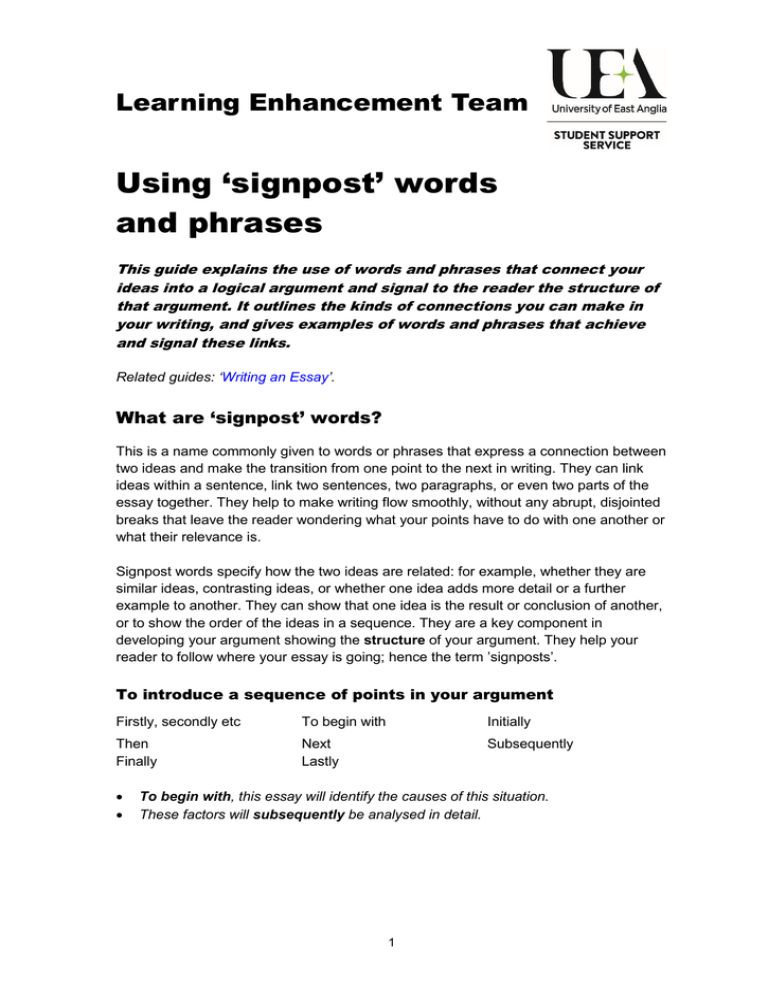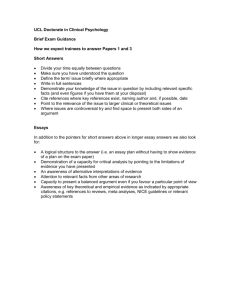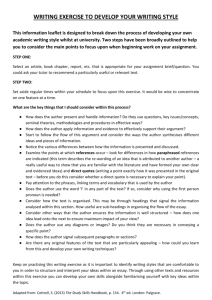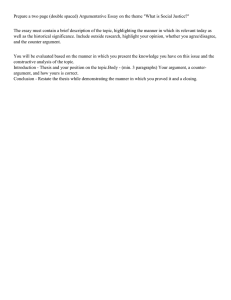Using `signpost` Words and Phrases
advertisement

Learning Enhancement Team Using ‘signpost’ words and phrases This guide explains the use of words and phrases that connect your ideas into a logical argument and signal to the reader the structure of that argument. It outlines the kinds of connections you can make in your writing, and gives examples of words and phrases that achieve and signal these links. Related guides: ‘Writing an Essay’. What are ‘signpost’ words? This is a name commonly given to words or phrases that express a connection between two ideas and make the transition from one point to the next in writing. They can link ideas within a sentence, link two sentences, two paragraphs, or even two parts of the essay together. They help to make writing flow smoothly, without any abrupt, disjointed breaks that leave the reader wondering what your points have to do with one another or what their relevance is. Signpost words specify how the two ideas are related: for example, whether they are similar ideas, contrasting ideas, or whether one idea adds more detail or a further example to another. They can show that one idea is the result or conclusion of another, or to show the order of the ideas in a sequence. They are a key component in developing your argument showing the structure of your argument. They help your reader to follow where your essay is going; hence the term ’signposts’. To introduce a sequence of points in your argument Firstly, secondly etc To begin with Initially Then Finally Next Lastly Subsequently To begin with, this essay will identify the causes of this situation. These factors will subsequently be analysed in detail. 1 To cross-reference to other parts of the essay As noted above / below As is discussed below As stated previously As noted previously, a number of scholars have offered a different explanation. This development is composed of a number of stages, as discussed above. To add an idea, or more detail In addition Moreover Also What is more Apart from this Additionally Again Similarly Equally Furthermore and Besides Indeed The issue is, furthermore, complicated by external matters. Indeed, scholars reject this theory as unrealistic. To give an example For example, As an illustration/example For instance To illustrate To demonstrate Certain research methods, for instance, surveys and questionnaires, are particularly effective. As an example, the following quotation could be cited as representative of this viewpoint. To focus on specifics in more detail In particular Specifically Such examples, and in particular those from the last five years, support the findings of recent research. To generalise As a rule In general Usually For the most part On the whole Generally In most cases In general, it is true to say that a good understanding of theory is essential. The conclusions are, for the most part, sound. 2 To introduce a comparison or further point to support your argument By the same token Compared with In like manner In comparison with Similarly In the same way Whereas Likewise Compared with the first example, the second seems unconvincing. This scholar’s argument is likewise flawed. To introduce a contrast or alternative point or section In contrast Nevertheless But Conversely However Nonetheless Yet By contrast, Although On the other hand Alternatively On the contrary Nevertheless, arguments in favour of the theory must also be considered. The case must not, however, be overstated. To introduce a fact or state the obvious (be careful with these – is your point obvious, or an assumption that needs to be proved?) After all Evidently It is evident that Clearly Obviously Naturally Of course These claims must, of course, be closely examined. Clearly, popular opinion is against the changes. To rephrase or explain In other words Or rather To put it more simply/in another way To be more precise That is to say Namely There is only one negative example, namely, that of the government. The model is not universal. To be more precise, it is not applicable in seven per cent of the above cases. 3 To introduce a reason, result, proof or logical conclusion Accordingly Consequently Thus Due to It could be concluded that As a consequence Hence For this reason Indeed As a result Therefore Because In fact The data are incomplete and, as a consequence, this interpretation is not convincing. Due to problems of access, research on this topic is scarce. To conclude In conclusion To sum up In short To conclude As this essay has demonstrated Finally In conclusion, it has been demonstrated that the hypothesis is generally supported by the evidence. Using Signpost words effectively The signpost words and phrases can be used at the start of sentences or, in most cases, in the middle or at the end, as demonstrated above. They can be very effective in the first sentence of your paragraph to indicate what the function of that paragraph is in the context of your argument, or in the middle of a paragraph to develop your point. They should be used with careful thought about their function. Good structure is more than a list of points, connected with signposts such as ‘also’, furthermore’, ‘in addition’, ‘the next point’. This may indicate that your argument is becoming descriptive rather than analytical. Be clear what the relationship between your points is. Variation in the kinds of signposts you use can indicate that you are critically analysing the issue and exploring the argument thoroughly, with contrasting views, more detailed development of points, and conclusions drawn. It is important to use signpost words and phrases accurately, as they can change the meaning of what you write. These two sentences have opposite implications: The government’s stance was resolute. However, the negotiations did not succeed. The government’s stance was resolute. Therefore, the negotiations did not succeed. 4 Summary These ‘signpost’ words and phrases make connections and transitions between the ideas in your writing. They help to make your argument clear to the reader by pointing out the relationship between your ideas, and where your line of thought is going. They can be used to signal the structure of your essay or the logical connections in your argument. Use them to link ideas within a sentence, or across sentences, paragraphs and sections of your essay. Want to know more? If you have any further questions about this topic you can make an appointment to see a Learning Enhancement Tutor in the Student Support Service, as well as speaking to your lecturer or adviser. Call: Ask: Click: 01603 592761 ask.let@uea.ac.uk https://portal.uea.ac.uk/student-support-service/learning-enhancement There are many other resources to help you with your studies on our website. Your comments or suggestions about our resources are very welcome. Scan the QR-code with a smartphone app for more resources. 5





